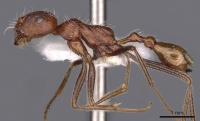Ocymyrmex shushan
| Ocymyrmex shushan | |
|---|---|

| |
| Scientific classification | |
| Kingdom: | Animalia |
| Phylum: | Arthropoda |
| Class: | Insecta |
| Order: | Hymenoptera |
| Family: | Formicidae |
| Subfamily: | Myrmicinae |
| Tribe: | Crematogastrini |
| Genus: | Ocymyrmex |
| Species: | O. shushan |
| Binomial name | |
| Ocymyrmex shushan Bolton, 1981 | |
Nothing is known about the biology of Ocymyrmex shushan.
Identification
A member of the hirsutus group. This bright orange species is characterized by a gastral constriction, an impressed clypeal margin, the strongly convex anterior portion of the dorsal alitrunk, and the shape of the petiole. (Bolton 1981)
Keys including this Species
Distribution
Distribution based on Regional Taxon Lists
Afrotropical Region: Namibia (type locality), South Africa.
Distribution based on AntMaps
Distribution based on AntWeb specimens
Check data from AntWeb
Countries Occupied
| Number of countries occupied by this species based on AntWiki Regional Taxon Lists. In general, fewer countries occupied indicates a narrower range, while more countries indicates a more widespread species. |

|
Estimated Abundance
| Relative abundance based on number of AntMaps records per species (this species within the purple bar). Fewer records (to the left) indicates a less abundant/encountered species while more records (to the right) indicates more abundant/encountered species. |

|
Biology
|
Castes
Known only from the worker caste.
Nomenclature
The following information is derived from Barry Bolton's Online Catalogue of the Ants of the World.
- shushan. Ocymyrmex shushan Bolton, 1981b: 277, fig. 31 (w.) NAMIBIA.
Unless otherwise noted the text for the remainder of this section is reported from the publication that includes the original description.
Description
Worker
Holotype. TL 6.7, HL 1.66, HW 1.58, CI 95, SL (antennae missing), PW 1.02, AL 2.14.
Anterior clypeal margin with a small but distinct median semicircular impression, which is flanked by a pair of short, acute teeth. Maximum diameter of eye 0.34, about 0.22 x HW. Sides of head behind eyes evenly convex and narrowing, rounding into the occipital margin with which, if it were not for the median impression in the latter, they would form a very regular arc. In profile the posterior pronotum and anterior part of mesonotum high and strongly convex, forming a dome-like outline above the level of the mesothoracic spiracles. Pronotum in front of this and mesonotum behind it sloping away evenly, increasing the dome-like appearance. Posterior portion of mesonotum and dorsum of propodeum more or less flat in profile, the latter rounding broadly into the convex declivity. Metapleural lobes small and low, rounded. Peduncle of petiole flat dorsally but sinuate ventrally. Petiole node in profile low dome-like, smoothly and evenly rounded. Postpetiole in profile subglobular. In dorsal view the petiole node much broader than long, all surfaces smoothly rounded; postpetiole slightly longer than broad. Base of first gastral tergite constricted and forming a neck behind the postpetiole. Dorsum of head finely and densely longitudinally rugulose, the rugulae diverging away from the midline posteriorly. Ground-sculpture between the rugulae a strong and conspicuous punctulation which in places seems as strongly developed as the rugular sculpture. Pronotum with a few strong transverse costulae on the cervical shield but behind this the costulae which arch up from the sides become very faint or vestigial when traversing the dorsum. Between the mesothoracic spiracles and extending for a short distance forwards and backwards is a patch of low longitudinal rugosity. Remainder of alitrunk and propodeal declivity transversely rugose or costulate. Petiole node smooth and shining, the anterior peduncle with some very faint transverse striae. Postpetiole unsculptured. Body everywhere lacking the conspicuous punctulate ground-sculpture which is so well developed on the head. All dorsal surfaces of head and body with numerous hairs, those on the first gastral tergite shorter and sparser than those on the alitrunk. Colour uniform bright orange.
Type Material
Holotype worker, South West Africa: Gobasis, 17.xii.l933 (J. Ogilvie) (The Natural History Museum).
References
- Bolton, B. 1981. A revision of six minor genera of Myrmicinae (Hymenoptera: Formicidae) in the Ethiopian zoogeographical region. Bulletin of the British Museum (Natural History) Entomology. 43:245-307. (page 277, fig. 31 worker described)
References based on Global Ant Biodiversity Informatics
- Bolton B., and A. C. Marsh. 1989. The Afrotropical thermophilic ant genus Ocymyrmex (Hymenoptera: Formicidae). Journal of Natural History 23: 1267-1308.


